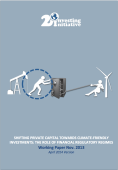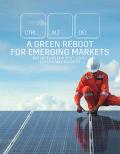
Part of the challenge of implementing green financial regulation is that there is currently very little analysis on green financial regulatory incentives. A crucial condition for achieving the 2° climate target is mobilizing capital for green investment. One estimate suggests a necessary cumulative investment of $36-$42 tn until 2030, or the equivalent of roughly $2 tn annually, to realize climate targets. Current investment levels however are only roughly $359 bn annually, giving rise to a 'green investment gap'. This study constitutes the first comprehensive overview of the range of instruments available to policymakers to align the financial sector with 2°investment scenarios.
There are several mechanisms that promote the funding of renewable energy (RE) and energy efficiency (EE) solutions. Following discussions with various financiers (commercial, alternative, developmental and governmental), this guideline unpacks the elements and factors considered by funders of RE and EE projects in South Africa.

The UNEP Adaptation Gap Report 2020 finds that while nations have advanced in planning, huge gaps remain in finance for developing countries and bringing adaptation projects to the stage where they bring real protection against climate impacts such as droughts, floods, and sea-level rise.

The paper first introduces the concept of a green recovery, setting out the importance and benefits of bringing this topic into the work of economy, finance and plan- ning ministries. It then breaks down the different components of a green recovery, providing a practical list of stakeholders, tools and outcomes. Finally, it summarises key takeaways for economic advisors to consider in their assignments.

The report analyzes the economic and climate benefits of a green post-COVID recovery, focusing on decarbonizing existing and future energy infrastructure, building climate-smart cities and helping speed the transition of key industries to green production practices.
